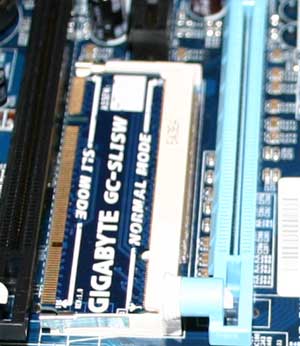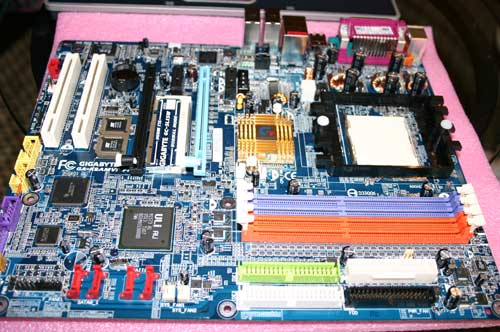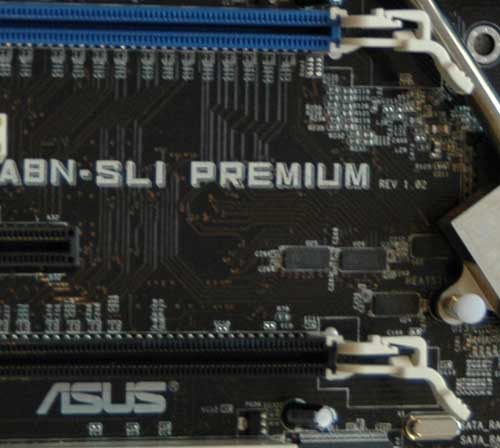ATI's Multi-GPU Solution: CrossFire
by Anand Lal Shimpi & Derek Wilson on May 30, 2005 9:00 PM EST- Posted in
- GPUs
What Happened to the Selector Card?
One of ATI's most interesting claims with their CrossFire solution is that you no longer need the selector card that is seen on nForce4 SLI motherboards. How is it that ATI is able to get around this requirement? Contrary to popular belief, it's not magic.By default, the nForce4 SLI chipset sends all 16 PCI Express lanes from the North Bridge to the first PCI Express x16 slot on a nForce4 SLI motherboard.
Flipping the selector card the other way divides the PCI Express lanes and sends the first 8 lanes to the first slot and the remaining 8 lanes to the second slot.
ATI's MVP chipset works slightly differently; by default, the North Bridge sends 8 PCI Express lanes to each of the two PCI Express slots. If you have two cards installed, then this is the desired configuration. However, if you only have one card installed, in order to get a full PCI Express x16 slot, one of the following methods must be implemented by the motherboard manufacturer:
Option 1 - Terminator Card
The first option is a terminator card that is installed into the second PCI Express x16 slot. This card simply reroutes the 8 PCI Express lanes going into the slot back to the first PCI Express slot, giving it all 16 PCI Express lanes.

Obviously, the downside to this approach is that you have to use a terminator card; we haven't heard of many manufacturers doing this.
Option 2 - SLI Selector Card
The second option is to implement the same selector card that is used in nForce4 SLI motherboards. If you want a single x16 slot, flip the card one way. If you want two x8 slots, just change its orientation and you are good to go.

The obvious downside here is that the user has to play with the selector card, something that ATI wants to avoid. Despite ATI's desire to avoid this card, some manufacturers are implementing it:

Option 3 - Selector ICs
The third (and most expensive) option is for the motherboard manufacturer to place a series of selector ICs (Integrated Circuits) on the motherboard itself, which will allow for the user to switch between one x16 slot or two x8 slots from within the BIOS. This is the most desired implementation from the end user's standpoint, but it is the most expensive option.
Either 4 or 5 chips have to be placed on the motherboard in order to allow for this software-selection of PCI Express configuration. Each chip costs the motherboard manufacturer approximately $1, which isn't really a problem for high end motherboards.

Note that there is also no reason why the same technology can't be implemented on nForce4 SLI motherboards; in fact, ASUS has already implemented it on their latest nForce4 SLI solution:











57 Comments
View All Comments
Panndor - Monday, June 13, 2005 - link
Lets hope that this endevor by ATI doesn't end up in the same situation at the RAGE Fury Maxx they came up with. The last time they tried this they screwed it up and then cut support for the card like it never existed.Looks promising, but I could see problems if they allow different hardware to run in a combined mode as well.
Competition is good so maybe this will bring down the price of the boards and the cards now.
vision33r - Wednesday, June 1, 2005 - link
Those 2 X850XT PE cards add up to $1000+ alone while price of 6800U are going down.I think the biggest prob is not if this works or not, is if the mainboard performance is sacrificed due to the ATI north-bridge. I don't gave 90% of the time on my system, I can't sacrifice losing system performance for gaming perf.
xsilver - Wednesday, June 1, 2005 - link
what's funny is that a few months after the xfire is released, nvidia will probably announce SLI v2.0 and then everyone will talk about how that's so coolWesley Fink - Wednesday, June 1, 2005 - link
#49 & #50 - The Uli 1573 we've seen paired with Crossfire DOES suport NCQ. this was confirmed this afternoon with engineers here at Computex. The upcoming ULI 1575 southtridge supports both Sata 2 and NCQ.We also saw demos of Splinter Cell on Crossfire with the 2.0 Shader. The demos were at 1280x1024 with all eye candy enabled. Frame rates in the various demos were 118 to 120. Since we did not have reference benches for Splinter Cell, it didn't make much sense to publish these results in the launch article. What we have seen is very promising, but we need more "hands-on" benchmarking before we can say much more.
Wesley Fink
mkruer - Wednesday, June 1, 2005 - link
#51 That is the real question to be answered. My guess is that ATI will work on a SLI board and visa versa unless there is something specifically in hard coded that prevents the second slot from being used by anything other the chipsets manufactures video card, which is highly unlikely. From the BIOS and driver standpoint the MB is either has 1x16 PCIex slot or 2x8 PCIex slots.elecrzy - Tuesday, May 31, 2005 - link
its possible to have Crossfire work on the NF4/945/955. Its just that ATI won't support them through the drivers. Sigh...kmmatney - Tuesday, May 31, 2005 - link
Does the ULi southbridge have NCQ support?weblizard - Tuesday, May 31, 2005 - link
No Sata II or NCQ support. That's all I need to know to NOT want a crossfire system.bob661 - Tuesday, May 31, 2005 - link
#47I had the Abit board with the AMD chipset on it. Worked flawlessly. I gave it to a friend when I upgraded that box and it was running until last year when he upgraded his box.
sprockkets - Tuesday, May 31, 2005 - link
26# That was the 760MPX or the dual processor chipset. Don't recall any irongate issues (that was 750, 760 was the DDR version, right?)